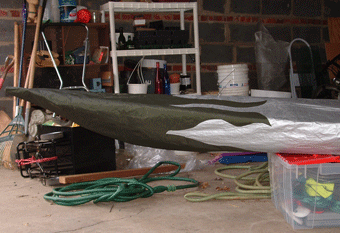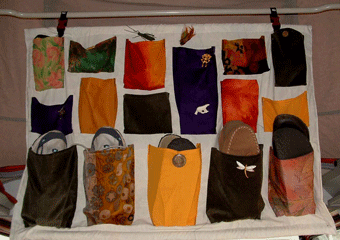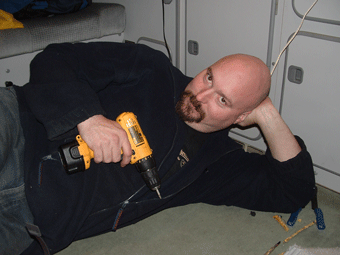
connected, where a shunt may help, and how to maintain the right blood flow throughout the system. But not knowing the language, I couldnít make much sense of it. Words flying back and forth Ė whatís the best battery, relays vs. switches vs. separators, vs. isolators, four gauge vs. six gauge vs. twelve gauge, alternators and solenoids and terminals and connectors. I was feeling less competent by the email.
Putting off this electrical puzzle, I got to work on a few other projects; a cover to protect my kayak from UV rays, a bag in which to strap long skinny things - paddles, kites, awning poles - onto the roof racks, a bag to hang shoes and knick-knacks, a waterproof bag to fit in the luggage rack. The kayak cover was fun Ė fit the fabric over the boat to get the shape, cut a second layer to create flame-like forms darting back from the bow where the cover takes the most wind and needs reinforcing.
With a dayís work it was almost done, fitted over the boat in the garage until I got the racks mounted and could do the final fitting. The awning was trivial Ė a line or two of stitching down the tarp, a little hood to catch the end of the pole. The paddle bag was an annoying exercise in sewing waterproof ripstop, but also trivial.
The knick-knack bag was the best. I dreamed it up to get my shoes off the floor of the van. It expanded into a dual purpose item, hung from the back of the seats as storage and swung from the poptop bar while camping as a screen so peeping toms canít see in the windshield. And it expanded from just a shoe bag to a bag with pockets in all sizes, shapes, and colors Ė purple damask from West Africa, pumpkin quilting scraps, heavy dark green corduroy, lovely orange and rose and green and gold that used to be curtains, brilliant red and orange cotton. I spent hours experimenting with colors and textures and size and placement before I finally sewed it together and hung it up to brighten Matildaís cozy cabin.
Somewhere along the line I realized that I may not know engines or electricity, but fabric has no power to scare me at all. The men on the vanagon list may have been messing with cars since they were boys, but Iíve been constructing things out of fabric since I was a

girl. I just laughed at the vanagon posts asking how to patch the poptop canvas Ė isnít it obvious to them? Yeah, as obvious as it is to me how to wire a battery!
Of course I can learn a lot from other peopleís expertise in sewing, too. Iíve never sewn the kind of vinyl Iíll use for the luggage rack bag but my friend Beth has, and she'll have advice. A friend of Susannaís pointed out that vinyl might crack in the cold, and that I should reinforce the seams with fabric tape so they canít tear on the dotted line. And my Aunt Libby in Richmond, has been a seamstress all her life and might love to help me make things if I visited for a few days. Relying on friends and relatives for sewing advice Ė thatís what women were always doing while the guys were fixing cars.
Back to the batteries, though, I finally thought to ask Beth if her husband Steve knew about these things
and could help. She vouched for his skills, he was happy to provide his time, and we set off on a shopping
adventure. A lot of money and a few days later we met up to begin installation of my new horrendously expensive
Optima battery and my pretty pricey SurePower Industries isolator.
Steve is great. Not only does he have all the sense about cars and wires and metal that I have about writing and analysis, he loves to teach. Everything I asked about heíd cheerfully explain, from uses for the hundreds of tools in his garage to how to wear the armor helmet and gloves on the table. (Steve and Beth are medieval re-enactors Ė they make the armor and fight battles in it for fun. Takes all types, eh?) And Steve isnít phased by what would be insurmountable obstacles for me, like removing rivets, drilling holes in steel plates, reading circuit diagrams. Full steam ahead, we plowed into the project.
We havenít gotten the battery running yet, but that wasnít anyoneís fault. Neither of us knew that the isolator Iíd bought on the advice of the man at the RV store wouldnít work in a vanagon, and I didnít have Matildaís wiring diagram so Steve couldnít have known that heíd picked the wrong wire to attach to the isolator. But by the end of the day, I had learned enough

to know what I needed to tell the folks at vanagon.com to find out what was wrong. And enough to figure out their answers, or at least to figure out what else to ask so Iíd understand their answers. And even enough to be able to choose a book to help me learn more, so that when my Bentley arrives tomorrow I might be able to understand it.
Progress! Maybe Iím educable? At any rate, Iíve got a whole new category of things to learn, and now that Iíve got red polish on my toenails, I think itís going to be a lot of fun.
Continue to the next entry. Return home.
Unless otherwise marked, all text and photos on this site ©Joy E. Hecht.